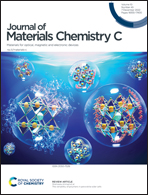Accelerated design for magnetic high entropy alloys using data-driven multi-objective optimization†
Abstract
High entropy alloys (HEAs) allow for attractive combinations of excellent mechanical and magnetic properties. The composition space of HEAs is enormous as it comprises multiple principal elements. Therefore, it is challenging to design HEAs with desired properties using the traditional trial-and-error strategy. In this work, a data-driven method was proposed to accelerate the design of magnetic HEAs with a decent combination of saturated magnetization and hardness. Machine learning models were trained to predict targeted properties using the selected features based on domain knowledge. Multi-objective optimization algorithms were designed to search for the optimal alloying compositions. The advantage of the multi-objective evolutionary method in directly identifying a set of optimal compositions with desired multiple properties was highlighted by comparison with traditional methods. As a proof of concept, several new high-performance magnetic HEAs were fabricated as suggested by the multi-objective optimization methods. The proposed data-driven combinatorial design method here would be applied to alloys with specific requirements, which could accomplish their accelerated design and engineering applications.



 Please wait while we load your content...
Please wait while we load your content...